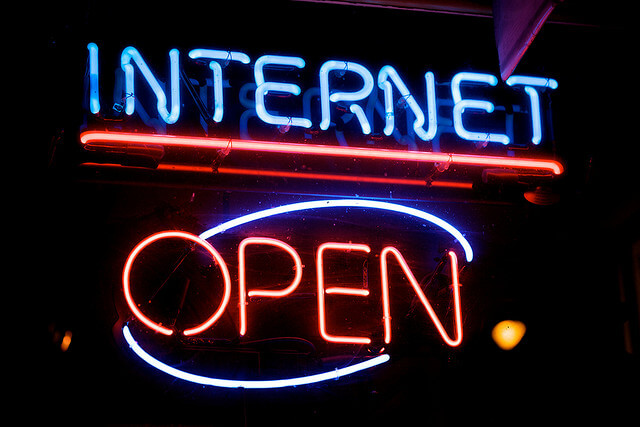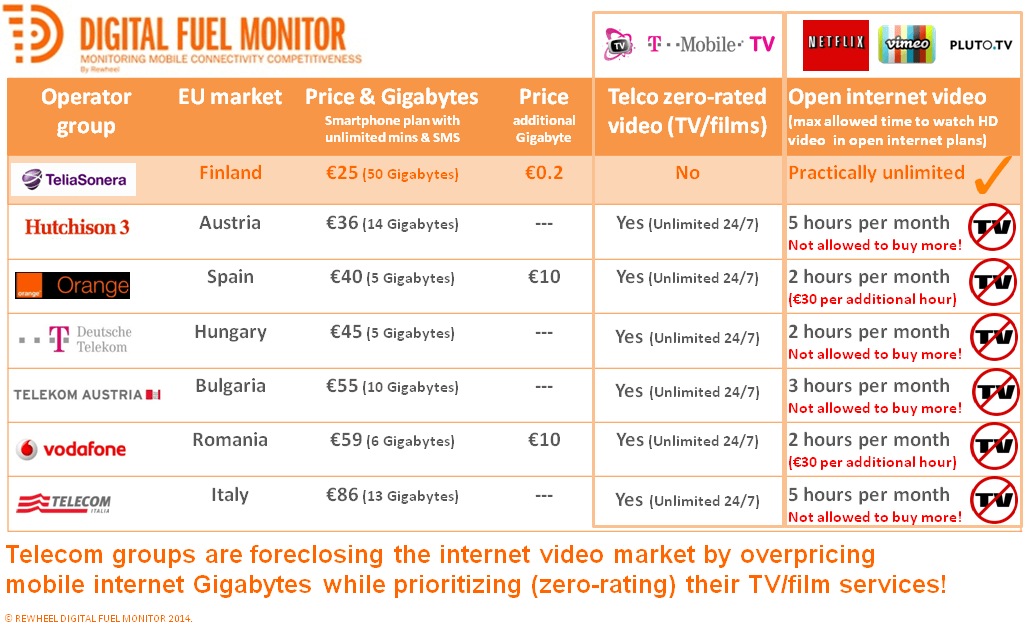In this two-part guest blog for the World Wide Web Foundation, Antonios Drossos of Rewheel discusses the potential threats of price discrimination.
Zero-rating has now become the neuralgic point in the net neutrality debate on both sides of the Atlantic
In Europe, ten small member states put forward a net neutrality proposal that, if adopted, would ban harmful price discrimination practices such as zero-rating. The proposal is fiercely opposed by big EU member states and their dominant telecom groups. The Netherlands and Slovenia, two countries that have already enshrined real net neutrality in their national laws, issued enforcement orders for zero-rating violations. In January, the Dutch Consumer and Markets Authority, ACM, fined Vodafone for zero-rating HBO Go mobile video streaming while the Slovenian regulator ordered Telekom Slovenia and Telekom Austria to stop zero-rating music streaming and cloud storage applications. Chile’s 2014 net neutrality legislation also bans price discrimination practices such as zero-rating. In 2014, the Norwegian, German and Austrian telecom regulators publicly asserted that zero-rating infringes net neutrality.
On the other side of the Atlantic, the Canadian telecom and media regulator (CRTC) has banned zero-rated mobile video streaming services while in the US the Federal Communication Commission (FCC) has released its much anticipated draft net neutrality rules. The FCC has proposed to reclassify broadband internet access service as a telecommunication service under Title II of the US Communication Act and centred its net neutrality proposal on three so called Bright Line Rules: 1) no blocking 2) no throttling 3) no paid prioritization commonly referred to as ‘fast lanes’.
In 2014 the net neutrality debate shifted from the narrow definition of no blocking and no throttling to an outright ban of paid prioritization
Back in 2013, Neelie Kroes, an ex Vice President of the European Commission responsible for the EU’s Digital Agenda, submitted her net neutrality version centred on two rules: 1) no blocking 2) no throttling. VP Kroes’s net neutrality ‘lite’ approach had much in common with FCC Chairman Tom Wheeler’s initial net neutrality proposal. While both proposals would have banned blocking and throttling they would have allowed paid prioritization. However, paid prioritization and ‘fast lanes’ were flat out rejected by the American and European consumers, digital start-ups, internet heavyweights and literally everybody else except the telecom and cable operators (ISPs) and their investors aspiring to becoming the de facto gate keepers of the internet.
The European Parliament’s and President Obama’s interventions in April and November 2014 respectively tipped the scales against paid prioritization and internet ‘fast lanes’. So has the open internet been saved and will it remain free from ISP discriminatory gate keeping practices?
No! Zero-rating and other harmful forms of price discrimination are eating away the neutrality of the internet
Zero-rating, the practice of not counting the traffic generated by ISPs’ own or their partners’ services against the end-users’ monthly volume (gigabyte) caps, has spread rapidly in 2014 from the emerging markets to Europe and North America. The Digital Fuel Monitor has tracked and reported 92 vertically price discriminated zero-rated mobile services in OECD countries as of November 2014. By late 2014, non-discriminatory neutral mobile internet access, free from zero-rating, was confined mainly to Scandinavia. Elsewhere in OECD 36 mobile operators were zero-rating their own data-hungry mobile video services while 10 operators were zero-rating their own mobile cloud storage services. Among the handful third party services that got zero-rated were Google’s YouTube & subscription film store, HBO’s GO mobile film store, music streaming apps such as Spotify and Deezer, WhatsApp, Facebook and Twitter.
Back in April 2014 in a GigaOM op-ed, we warned that zero-rated traffic is blunt anti-competitive price discrimination designed to favour mobile operators’ own or their partners’ services while placing competing internet services at a disadvantage. A zero-rated app is an offer consumers can’t refuse, I wrote. The telecom industry dismissed our assertions as fear mongering and was quick to highlight the positive side of zero-rating. Indeed, zero-rating enables poor and disadvantaged communities that do not have access to affordable fixed broadband or cannot afford mobile internet subscriptions, to gain access to parts of the internet. Or to be more precise, to gain access to Facebook or ISPs’ walled gardens. Zero-rating data-light applications such as Facebook in emerging markets where even the tiniest volume of open mobile internet (e.g. 500MB per month) is unaffordable to the masses causes consumer and competitor harm. In OECD markets, where open mobile internet usage prices are, generally speaking, more affordable for data-light applications such as Facebook and Twitter than in emerging markets, ISPs eye the data-hungry mobile video and cloud markets. As shown in the table below, by zero-rating their own mobile TV & film store services, operators are foreclosing the mobile internet video market by placing all other competitors (e.g. Netflix, Vimeo) at a disadvantage. Zero-rated video offered by mobile operators is an offer consumers cannot refuse. Watching third party internet video over their open mobile internet plans instead of the zero-rated ones would eat up the monthly data allowances in the matter of hours or set them back few hundred EUR per month. That is clear!
Digital Fuel Monitor has shown in November 2014 that in many OECD markets, where mobile operators launched zero-rated film stores and TV services, consumers are either not allowed to buy more than a few (5-10) gigabytes at all or most likely, they cannot afford to buy more because the price of additional gigabytes is prohibitively expensive (e.g. €10 per gigabyte). Consumers are harmed because their choice of internet video services is severely restricted.
Zero-rating is particularly harmful in mobile internet access markets where ISPs collectively set low volume caps. In most fixed internet access markets where gigabyte volumes are unlimited and as well in few mobile internet access markets where gigabyte volumes are very accommodative (e.g. Finland) zero-rating poses a benign threat. However, this could soon change. In 2013, Deutsche Telekom announced a plan that will cap the volume of fixed internet access connections but it will exempt its own IPTV (zero-rated) video service. The reaction from German authorities was swift. A German court blocked Deutsche Telekom’s plan on the basis of consumer protection law while the German telecom regulator Bundesnetzagentur carried out an investigation and warned Deutsche Telekom that zero-rating could infringe net neutrality.
Stay tuned for the second part of this guest blog, which will be published tomorrow.
Antonios Drossos is the Managing Partner of Rewheel http://www.rewheel.fi/ a Helsinki based consultancy that specializes in pro-competitive telecom strategies.
The Digital Fuel Monitor www.dfmonitor.eu service is founded and operated by Rewheel.
Photo under a Creative Commons licence by Jeremy Brooks – The Internet is Open.


